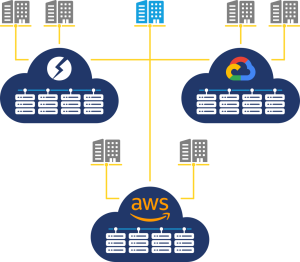Cloud Hosting
The 5 main cloud deployment models you should know

I often write about public cloud and private cloud, sometimes touching on hybrid cloud, and to a lesser extent multi cloud and community cloud. They are collectively known as cloud deployment models, with each individual deployment model relevant to specific use cases. The differences between the individual deployment models will help you know which you should choose, and when.
Public Cloud

The defining characteristics of the public cloud are that it is cloud infrastructure available to the general public and it operates on a multi-tenancy model. The hardware infrastructure is owned and operated by a cloud service provider.
The public cloud is one of the most popular cloud deployment models since it offers both affordability and operational flexibility. The latter is especially evident with elastic scalability, which simply means resources can be scaled up or down as needed – usually upwards to cater for spikes in traffic or compute resource requirements. Once the spike has subsided, resources are scaled down, thus delivering efficiency.
Since access to a public cloud is typically offered on a pay-as-you-use model, it’s easier to control what you spend.
Advantages of a public cloud
- Affordable: Pay only for the resources you use, when you use them.
- Scalable: Meet resource demands head-on without any long-term commitments.
- High availability: This refers to redundant infrastructure which ensures that there’s no single point of failure to disrupt your cloud services.
- Security: Public cloud providers typically invest heavily in security measures, often delivering better security than what many organisations can provide on their own.
- Easy to use: Public cloud providers typically offer a user-friendly interface that allows even non-technical users to quickly and easily deploy applications and services.
Disadvantages of a public cloud
- Vendor lock-in: This occurs when the organisation becomes too dependent on a public cloud service provider. Switching to another provider is either very expensive or simply not feasible.
- Limited control: Organisations have little or no control over the public cloud infrastructure. This becomes problematic when an organisation has to adhere to strict compliance requirements or regulations about where and how data is stored.
- Security: While public cloud providers invest heavily in security, it doesn’t mean that the public cloud is without risks.
- Shared environment: While the public cloud offers more stability and guaranteed resources than, say, shared hosting, it remains a shared environment which comes with its own suite of potential problems (e.g. network congestion).
Private Cloud

A private cloud, also known as an “internal cloud”, is a single-tenant cloud where both the hardware infrastructure and cloud environment is dedicated to one organisation. The physical infrastructure of a private cloud is owned by a cloud service provider, or by the organisation itself.
If you’re new to cloud computing, it might seem like there’s little difference between a private cloud and a data centre setup. But a private cloud still offers the benefits of a cloud environment such as on-demand infrastructure (e.g. virtual servers) and elastic scalability.
Other features such as security and high availability will depend on who owns the hardware infrastructure: organisations will have to procure redundant infrastructure and hire security professionals while hosting service providers already have redundancies and security measures in place.
Advantages of a private cloud
- Full control: Unlike public cloud environments, organisations typically have more control over their private cloud infrastructure. This is especially beneficial for organisations that have compliance requirements, or who wish to avoid vendor lock-in.
- Security: Even though the public cloud can provide tough-as-nails security, there is still the potential for security risks imposed by other tenants. Private cloud also offers “security through obscurity”, meaning that much or all of the infrastructure is hidden away from the public internet.
- Performance: Network congestion and similar factors that can affect public cloud performance are potential non-issues in a private cloud environment. I say “potential” because where the private cloud is owned by the organisation, budgets and the availability of suitable in-house skill sets will define the performance of the cloud.
- Customisability: Private cloud deployments can be customised to meet the specific needs of an organisation, including the hardware and software used, network configuration, and security measures.
Disadvantages of a private cloud
- Cost: If you’re running your private cloud in-house you’ll have to procure all the required hardware and, if not already available, the expertise to design, set up, and manage the cloud. These costs may be lower with cloud service providers since they’ve already got the hardware and required skill sets in place.
- Limited scalability: Private cloud deployments are limited by the resources available to the organisation that owns them. Again, this applies more to in-house private cloud setups since service providers are better equipped to customise cloud configurations.
- Maintenance and management: Private cloud deployments require ongoing maintenance and management, including monitoring, updates, and troubleshooting. This can be a significant burden for organizations with limited IT resources.
- Lack of elasticity: Private cloud deployments may lack the elasticity of public cloud deployments which can make it more difficult to respond to sudden spikes in demand.
Hybrid Cloud

A hybrid cloud combines both public and private deployment models. Here the IT infrastructure is split between a private cloud environment dedicated to the organisation, and a multitennant public cloud environment. Hybrid clouds are typically deployed to provide organisations with the privacy and security of the private cloud (e.g. for compliance and storage of sensitive data) but also the scalability and cost-effectiveness of the public cloud (e.g. for development and testing, or storage of non-critical data).
Organisations typically use a cloud management platform that can manage both private and public cloud resources and provide a single view of the infrastructure.
Advantages of a hybrid cloud
- Scalability: Hybrid clouds are scalable, which helps organisations meet spikes in demand without risking under- or overprovisioning of resources.
- Flexibility: With a hybrid cloud organisations can choose where to run workloads and store data. This helps organisations optimise performance, cost, and security.
- Security: Control of private cloud infrastructure simplifies tailored security and adherence to compliance requirements.
- Disaster recovery: Hybrid cloud environments can provide an effective disaster recovery solution by using the public cloud for backups and the private cloud for critical workloads.
- No vendor lock-in: Careful management of cloud services and where they are run can help organisations avoid vendor lock-in.
Disadvantages of a hybrid cloud
- Complexity: Setting up, managing, and maintaining a hybrid cloud can be complex. It requires specialised knowledge and the right tools and resources to manage the different environments.
- Cost: Getting a hybrid cloud up and running can be expensive, especially when those skills aren’t available in-house.
- Security: The increased complexity of a hybrid cloud environment can increase an organisation’s risk of exposure to online attacks.
- Latency: Organisations can experience latency issues due to the location of data and applications across different cloud environments. This can have an impact on performance and user experience.
Multi-cloud

Where a hybrid cloud combines public and private cloud environments, a multi-cloud combines public cloud environments from multiple cloud service providers. Organisations typically choose a multi-cloud deployment model to essentially cherry-pick preferred cloud services at the best prices. Another motivation for a multi-cloud solution is the potential for higher service availability when using different cloud service providers as redundancies.
Advantages of a multi-cloud
Flexibility: Choose the cloud provider best suited to handle a specific workload. Data and applications configured for a multi-cloud environment can be moved between different providers more easily.
Resilience: Multiple cloud providers can be employed for workloads as redundancies to ensure high service availability.
Cost optimization: By leveraging different cloud providers, organisations can take advantage of pricing and services from different providers to optimise costs and avoid vendor lock-in.
Innovation: Multi-cloud deployments can enable access to a greater variety of cloud services and technologies. This enables organisations to take advantage of the latest cloud innovations.
Disadvantages of a multi-cloud
- Complexity: Managing multiple cloud providers can be complex in terms of deployment, monitoring, and governance.
- Integration: Integration can be a challenge, especially when each provider has their own APIs, management tools, and security policies.
- Vendor sprawl: This occurs when an organisation becomes too reliant on multiple vendors, each with their own ecosystem of services, tools, and APIs.
- Compliance complexity: Different vendors may have different compliance requirements, making it difficult to ensure compliance across different public cloud environments.
- Security: Managing security across multiple cloud providers can be challenging, as each provider may have different security policies and tools. This can make it difficult to create a unified security framework and identify security threats across the different environments.
Community cloud

A community cloud resembles a private cloud setup, with the exception that it can have multiple tenants that all share common interests or requirements. As such community cloud setups are often purpose built to meet the needs of the community.
Advantages of a community cloud
- Affordable: Shared resources means shared costs, making the cloud environment more affordable for all tenants.
- Bespoke: A community cloud can be built to meet specific needs.
- Security: Community cloud deployments allow the sharing of security resources among tenants, which can deliver robust security.
- Compliance: Community cloud deployments can be tailored to meet the specific regulatory and compliance requirements of the community members.
- Full control: As with a private cloud, tenants have full control over the cloud infrastructure.
Disadvantages of a community cloud
- Limitations: Even though community clouds can be customised to meet the needs of a community it might not meet all the needs of individual members.
- Lock-in: Members of the community may become too dependent on the infrastructure, making future migrations both difficult and costly.
- Complexity: Community cloud deployments can be complex since they require coordination and collaboration between multiple organisations.
- Resource allocation: Competition for available resources can occur if the cloud infrastructure isn’t scaled up fast enough. As such, resource allocation and usage requires careful monitoring and management.
Wrapping up
It’s easy to choose the right cloud deployment model when you know what the differences are between them.
But, just in case you’re still struggling to make a decision, here’s what we recommend:
- Choose a public cloud setup if you have budget constraints or if you need a single virtual server for your website.
- A private cloud is geared toward organisations that have compliance requirements and that need to store sensitive information away from the public eye.
- The hybrid cloud gets you the best of both worlds, and is very popular among SMEs.
- Not all cloud service providers do everything equally well, which is why there’s the multi-cloud model – choose the best provider to run a particular service, or choose multiple providers as redundancies.
- The community cloud deployment model is essentially a private cloud setup shared between entities that have common interests and therefore similar infrastructure requirements.
Then again, you can always just give us a call and have a chat with one of our cloud architects for expert advice that’ll help you move forward.
Speak with a Storm Expert
Please leave us your details and we'll be in touch shortly
A Trusted Partner








